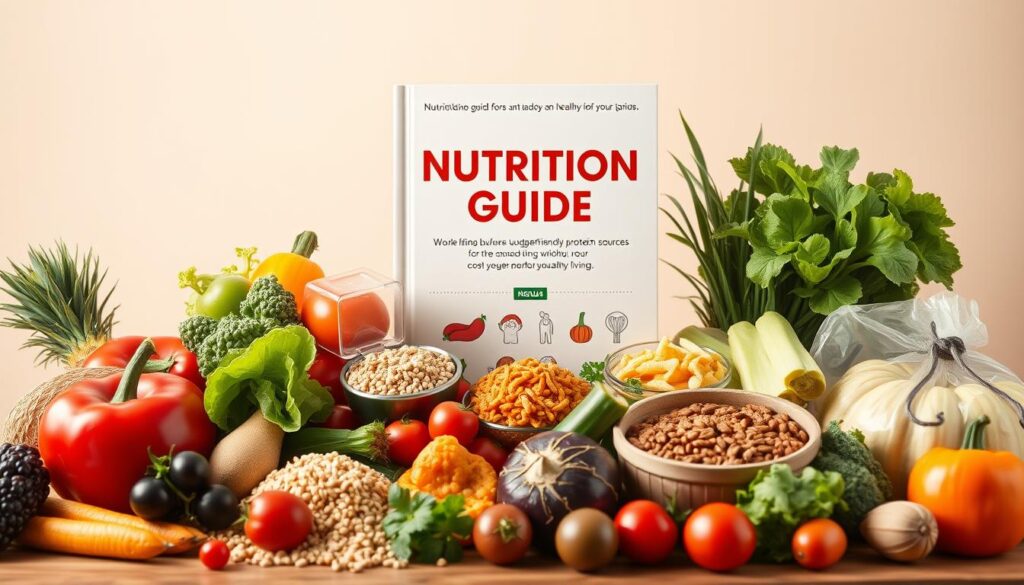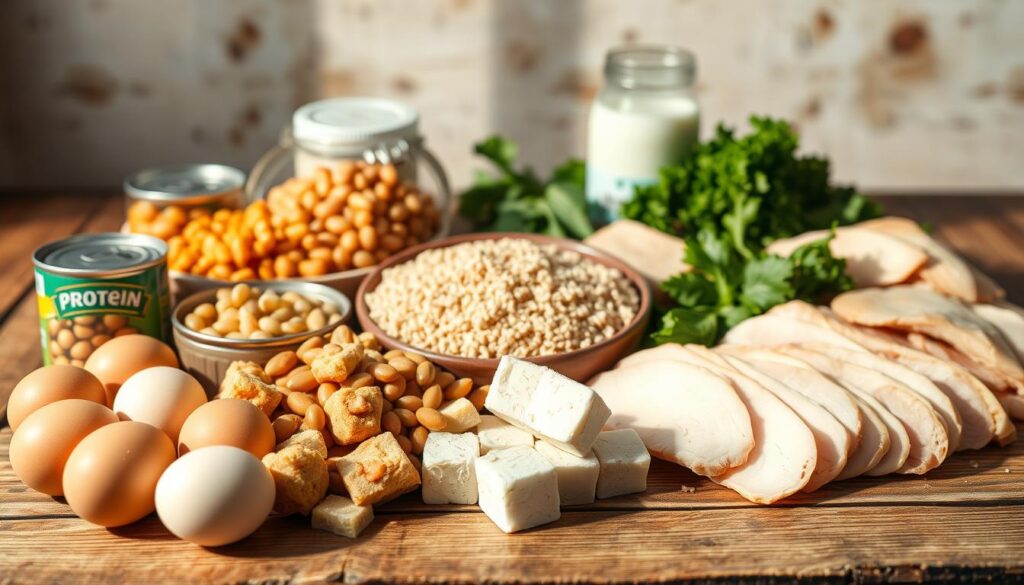Affordable Healthy Diet Plan for Weight Loss
Starting a weight loss journey can feel overwhelming, especially when you think about the cost. Many think that eating healthy is expensive. But, it’s possible to lose weight without spending a lot.
A good affordable healthy diet plan is essential for losing weight. It’s not just about eating less. It’s about eating foods that are good for you. By choosing whole, nutritious foods, you can make a healthy eating plan that lasts.
Key Takeaways
- Eating healthy doesn’t have to be expensive.
- A well-planned diet is crucial for weight loss.
- Focus on whole, nutrient-dense foods.
- Create a sustainable eating plan.
- Nourish your body, not just cut calories.
The Science Behind Weight Loss and Nutrition
Weight loss isn’t just about dieting; it’s about understanding the science behind it. To achieve a healthy weight, knowing nutritional principles is key. A balanced diet that’s both affordable and nutritious is essential for a successful weight loss journey.

Caloric Deficit: The Foundation of Weight Loss
A caloric deficit happens when you burn more calories than you eat, leading to weight loss. You can do this by eating fewer calories or exercising more. An affordable nutritious eating program should help you create a sustainable caloric deficit without missing out on important nutrients.
To effectively create a caloric deficit, you need to know your daily calorie needs. Adjust your diet to meet these needs. This might mean choosing low-cost healthy diet regimens that are full of nutrients but low in unnecessary calories.
Nutrient Density vs. Empty Calories
It’s important to know the difference between nutrient-dense foods and empty calories. Nutrient-dense foods give you vitamins, minerals, and other good stuff. Empty calories, on the other hand, offer little to no nutritional value. Adding more nutrient-dense foods to your low-cost healthy diet regimen can help with weight loss.
By eating whole foods like veggies, fruits, lean proteins, and whole grains, you can make a diet that’s good for weight loss. These foods are not only healthy but can also fit into an affordable nutritious eating program.
Creating an Affordable Healthy Diet Plan for Sustainable Results
To lose weight in a way that lasts, you need a diet plan that’s both affordable and works well. This means setting goals that are realistic, balancing what you eat with your budget, and making the plan fit your long-term goals.
Setting Realistic Weight Loss Goals
It’s key to set weight loss goals that you can reach. Aim to lose 1-2 pounds each week for a steady weight loss. You can do this by eating fewer calories and exercising more.
Balancing Nutrition and Budget Constraints
Eating well doesn’t have to be expensive. Plan your meals with foods that are full of nutrients but won’t break the bank. Use seasonal produce, whole grains, and lean proteins. Here’s a table to help you eat well without spending too much:
| Nutrient | Food Sources | Budget Tips |
|---|---|---|
| Protein | Beans, lentils, chicken, fish | Buy in bulk, choose seasonal |
| Whole Grains | Brown rice, quinoa, whole wheat bread | Opt for store brands, buy in bulk |
| Fruits and Vegetables | Seasonal produce, frozen alternatives | Shop at local farmers’ markets, plan meals around sales |

Customizing Your Plan for Long-Term Success
To keep losing weight, make your diet plan fit your life and tastes. You might need to change what you eat, try new recipes, and drink plenty of water. Making lasting changes in your lifestyle can help you keep the weight off.
By following these steps and sticking to your goals, you can make a economical healthy eating plan. This plan will support your wellbeing and help you achieve a cost-effective wellbeing diet.
Budget-Friendly Nutrition Essentials
It’s possible to eat healthy without spending a lot. Knowing the basics of nutrition and how to do it on a budget is key. This helps you lose weight without spending too much money.
Macronutrients on a Budget
Macronutrients are the building blocks of a healthy diet. They give us energy and help our bodies grow and repair. It’s important to balance protein, carbs, and fats for health and weight control.
Protein, Carbs, and Fats That Won’t Break the Bank
Protein sources like beans, lentils, and eggs are both affordable and nutritious. Carbs from oats, rice, and veggies are cheap. Healthy fats from nuts, seeds, and avocados can also be part of your diet.
Optimal Macronutrient Ratios for Weight Loss
For weight loss, eat a balanced diet with a bit less calories. Aim for 15-20% of daily calories from protein, 45-55% from carbs, and 20-30% from fats. But, your needs can change based on your age, sex, and how active you are.

Affordable Sources of Essential Micronutrients
Micronutrients like vitamins and minerals are vital for health. Luckily, many foods rich in them are also cheap.
| Micronutrient | Affordable Sources | Benefits |
|---|---|---|
| Vitamin C | Oranges, Bell Peppers, Broccoli | Boosts Immune System |
| Iron | Lentils, Spinach, Fortified Cereals | Essential for Healthy Red Blood Cells |
| Calcium | Milk, Yogurt, Kale | Supports Bone Health |
By adding these affordable nutrition basics to your diet, you can eat well and lose weight. You won’t have to spend a lot of money to do it.
Smart Shopping Strategies for Healthy Eating
Smart shopping is key to eating healthy without spending too much. By using a few smart shopping habits, you can eat well and save money.
Meal Planning Before Shopping
Plan your meals before you go shopping. This helps you avoid buying things you don’t need and cuts down on waste. Take time to plan your meals, making sure they include lots of healthy foods. Make a shopping list from your meal plan to stay on track.
Seasonal Shopping for Maximum Savings
Buying produce in season can save you money. Seasonal fruits and veggies are cheaper because they’re more common. Check your local farmer’s market or grocery store to see what’s in season. You can also find recipes online that use seasonal ingredients, making meal planning easier.

Bulk Buying and Store Loyalty Programs
Buying things in bulk can save you money over time, especially for things that don’t spoil. Also, joining store loyalty programs can give you special discounts and rewards. Using bulk buying with loyalty programs can save you even more. Just make sure to store your bulk items well to keep them fresh.
By using these smart shopping tips, you can eat healthy and balanced without breaking the bank. It’s all about being smart with your shopping and making good choices.
Affordable Protein Sources for Weight Loss
Adding protein to your diet doesn’t have to cost a lot. There are many affordable options. Protein is key for weight loss as it builds and repairs muscles. This keeps you feeling full longer. A low-cost healthy diet regimen can include many protein sources from plants and animals.
Plant-Based Protein Options
For those who prefer or need plant-based diets, there are many affordable choices. Legumes, like beans and lentils, are packed with protein, fiber, and nutrients.
Legumes, Tofu, and Other Vegetarian Staples
Legumes, such as black beans, chickpeas, and lentils, are great for many dishes. Tofu is another excellent protein source that can be marinated and cooked in many ways.
Protein-Rich Grains and Seeds
Grains like quinoa and seeds like chia and hemp are also high in protein. They’re easy to add to meals as sides or toppings for salads and yogurt.
Budget-Friendly Animal Proteins
For those who eat animal products, there are many affordable options. Eggs and dairy products are rich in protein and other important nutrients.
Eggs and Dairy Products
Eggs are versatile and affordable, perfect for any meal. Dairy products like milk, yogurt, and cheese offer protein and can be used in many recipes.
Economical Meat and Fish Choices
Canned fish like tuna and salmon are affordable and full of protein and omega-3s. Buying certain cuts of meat in bulk can also be cost-effective and protein-rich.

Low-Cost Fruits and Vegetables for Optimal Nutrition
A cost-effective wellbeing diet is about making smart choices. It’s not just about saving money. Eating affordable fruits and vegetables is key. You can have a healthy diet without spending too much.
Seasonal Produce Guide for Year-Round Savings
Eating seasonally helps you save on fruits and vegetables. Produce in season is cheaper because it’s more available. Planning meals around seasonal items means you get variety all year.
Here’s a simple seasonal guide:
- Spring: Asparagus, spinach, and strawberries
- Summer: Tomatoes, zucchini, and blueberries
- Fall: Apples, squash, and carrots
- Winter: Citrus fruits, kale, and root vegetables
Frozen and Canned Alternatives Without Sacrificing Nutrition
Frozen and canned fruits and vegetables are great alternatives. They’re often cheaper and last longer. Frozen produce is frozen at its peak, keeping nutrients in.
Tips for using frozen and canned produce:
- Choose frozen vegetables without added sauces
- Opt for canned fruits in their own juice, not syrup
- Rinse canned vegetables to reduce sodium content
By using these tips, you can have a cheap and healthy diet. You’ll enjoy a variety of fruits and vegetables without breaking the bank.
Economical Whole Grains and Healthy Carbohydrates
Healthy carbs, especially whole grains, are key for a balanced diet that won’t break the bank. They offer fiber, vitamins, and minerals essential for health. The best part? Adding them to your meals can be both affordable and tasty.
Bulk Bin Treasures: Rice, Oats, and Beyond
Buying whole grains in bulk saves money. Grains like rice, oats, quinoa, and barley are cheap and versatile. They’re great for breakfast porridges, salads, and side dishes.
Buying in bulk has many benefits:
- Less packaging waste
- Lower cost per unit
- Always have staples on hand
| Whole Grain | Average Cost per Pound (Bulk) | Nutritional Highlights |
|---|---|---|
| Oats | $1.50 | High in fiber, protein |
| Quinoa | $2.50 | Complete protein, rich in minerals |
| Brown Rice | $1.25 | Good source of manganese, selenium |
Incorporating Whole Grains into Daily Meals
Adding whole grains to your meals is easy. Begin with oatmeal or whole-grain toast for breakfast. For lunch, try salads with quinoa or brown rice. Dinner can feature whole grains as sides or bases for main dishes.
Tips for meal planning: Plan meals around seasonal and sale items. Use leftovers to cut down on waste.
Meal Prep Techniques to Save Time and Money
Effective meal preparation is key to maintaining an economical healthy eating plan. By dedicating a few hours each week to meal prep, individuals can save time and money. They ensure they have healthy meals ready throughout the week.
Batch Cooking Fundamentals
Batch cooking involves preparing large quantities of a single ingredient or entire meals. These can be reheated or used in various dishes throughout the week. This technique is fundamental in reducing food waste and saving money on groceries.
- Cook grains and legumes in bulk.
- Roast a variety of vegetables at once.
- Prepare proteins like beans, lentils, or chicken that can be used in multiple meals.
Storage Solutions for Prepared Meals
Proper storage is crucial for maintaining the freshness and safety of prepared meals. Using airtight containers and labeling them helps in keeping track of what has been prepared.
Preventing Food Waste and Maximizing Ingredients
Planning meals around what’s already in the pantry and fridge can significantly reduce waste. Using every part of an ingredient, like vegetable scraps for broth, is another effective strategy.
| Ingredient | Primary Use | Secondary Use |
|---|---|---|
| Carrots | Salad | Soup or juice |
| Chicken bones | Broth | Stock for cooking grains |
7-Day Affordable Healthy Diet Plan for Weight Loss
Eating healthy doesn’t have to be expensive. A good diet can be both affordable and nutritious. Here’s a 7-day diet plan with breakfast, lunch, dinner, and snack ideas. These are healthy and won’t empty your wallet.
Breakfast Options Under $2
Starting your day with a nutritious breakfast doesn’t have to cost a lot. Try oatmeal with fruits or scrambled eggs with spinach. These meals are cost-effective and full of nutrients to keep you energized all morning.
Budget-Friendly Lunch Ideas
For lunch, choose meals like lentil soup or grilled chicken salad. These are affordable and can be made ahead of time. They save you time and money.
Economical Dinner Recipes
Dinner can be both healthy and budget-friendly. Try dishes like vegetable stir-fry with tofu or baked salmon with quinoa. These meals are low-cost and full of important nutrients.
Low-Cost Healthy Snacks
Snacking is key to a healthy diet. Go for snacks like carrot sticks with hummus or a piece of fruit. These are healthy and won’t hurt your budget, fitting well into a cost-effective wellbeing diet.
By adding these meal ideas to your daily routine, you can reach your weight loss goals without spending too much. This 7-day diet plan is a step towards a healthier, more affordable lifestyle.
Overcoming Common Challenges of Budget Dieting
Budget dieting comes with its own set of challenges. But, knowing how to tackle them can lead to success. When trying to eat cheap and healthy, people often face obstacles that can stop their progress.
Dealing with Food Cravings Without Expensive Alternatives
One big challenge is fighting off food cravings without spending a lot. It’s key to have affordable, healthy options available. For example, choosing seasonal fruits or making your own snacks can curb cravings without costing too much.
Planning your meals and snacks ahead is a smart move. This way, you always have something healthy to eat. Here’s a comparison of costs for sweet treats:
| Snack Option | Cost per Serving |
|---|---|
| Homemade Oatmeal Cookies | $0.50 |
| Store-Bought Granola Bars | $1.50 |
| Dried Fruits | $0.75 |
Maintaining Motivation on a Limited Budget
Staying motivated on a tight budget is another challenge. Setting achievable goals and celebrating small wins can keep you going. Finding a community or a friend with similar goals can also offer support and encouragement.
Visual reminders of your progress, like a weight loss journal or a before-and-after photo, can be very motivating. By focusing on your goals and remembering your progress, you can stay motivated to follow your budget diet plan.
Conclusion
Weight loss and good health don’t have to cost a lot. By using an affordable healthy diet plan, you can make lasting changes. This means creating a diet plan that fits you, buying smart, and cooking meals ahead of time.
An affordable healthy eating plan includes foods rich in nutrients but low in cost. This includes affordable proteins, fruits and veggies, and whole grains. Using meal prep and seasonal produce can save you time and money.
Following the tips in this article helps you create a healthy eating plan that fits your budget. Starting an affordable healthy diet is a big step towards a better, more balanced life.




